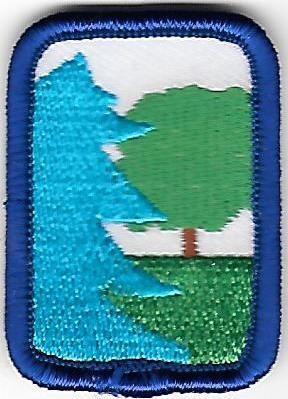Forester Central MD Council own IP (Original)
Requirements:
Skill Builder
1. Pick a place (your house or meeting place) and draw an aerial view or plan of the site. Locate any buildings or trees on the plan. Identify the individual trees and determine the trees height and diameter at breast height (dbh).
2. Every profession has a language all its own. In order to talk to foresters, you need to learn the “lingo”. Find out what the following terms mean: diameter at breast height, Biltmore stick, basal area, forest association, canopy, forest, hardwood, watershed, understory, overstory, thinning, stand, softwood, regeneration, harvest, forest types, dominant tree, deciduous, evergreen, cruise, and caliper. Tell your troop what you have learned.
3. Examine a cross-section from a large tree or tree stump. Look for annual growth rings and estimate the age of the tree by counting the rings. What history has the tree lived through? Notice the differences in the width of the rings. Why are some rings thicker then others?
4. Learn about the different geographical regions in Maryland. Compare and contrast the types of trees that make up the forest in each region. Find out why there are differences and the adaptations utilized by different tress to survive in different soils and climates.
5. Learn about the different silvicultural practices used to manage forests. Compare and contrast the following different practices: clear cutting, seed-tree, shelterwood, single tree selection and group selection. Share you information with your family or troop or other group.
6. Become a forest ecosystem detective. Visit a meadow or other un-mowed field and look for seedlings among the grass. Found out how a meadow becomes a forest. Draw a poster that explains the process.
Technology
1. Obtain an aerial view for your house or meeting place or other public area from the internet and determine the amount of forest cover for area.
2. Maryland has adopted laws that protect trees and forests throughout the state. Do a web search to find out more about the laws (Reforestation Law, Forest Conservation Act, and the Roadside Tree Law). Discuss why these laws are in place and the benefits from them. Also read Dr. Seuss’s “The Lorax”.
3. Forest management has changed over time. How has forest management techniques changed? Why have they changed? What impacts do the changes have on the health of the forest and the industries dependent on forest products? 04-3115 1/2007 Proposed by Maryland Forest Service contact Marian Honeczy (410) 260-8511 for more information 9/8/06
4. Tour a demonstration forest. What kinds of equipment are used to harvest trees?
5. The Wye Oak is Maryland’s state tree. Find out the history of the Wye Oak.
Service Project
1. Learn how to plant seedlings, containerized and ball and burlap trees. Discuss how to care for the trees and seedlings after the planting such as how to water, mulch and fertilize correctly. Then plan a tree planting or participate in an Arbor Day or Earth Day Celebration. Maryland celebrates Arbor Day on the first Wednesday of April while National Arbor Day is the last Friday of April. Earth Day is celebrated on April 22.
2. Create a display for the public regarding a different country’s forests’ species and forest products.
3. Develop an educational game or coloring book for younger girls that will help them learn more about the forest ecosystem.
4. Assist with a local project to remove exotic and invasive species from a local park or other site.
5. Take a younger troop for a hike through the forests and explain what you know.
Career Exploration
1. Do a college search to find out what schools offer programs in forestry and other related fields. Write to one or more colleges and find out about their course offerings.
2. Read about an individual who has done work involving trees and forests or who has had an impact on public lands.
3. Find out the differences and similarities between urban forestry and traditional forestry fields. Interview a member from one of the fields
4. Capture the beauty of an individual tree or the forest by camera, sketch pad or by writing a poem or song about the forest.
